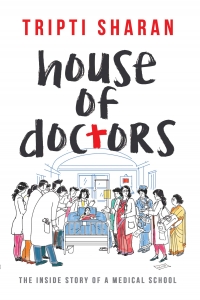
‘Sister, where would the labour ward be?’ He stopped in front of us and asked, a little unsure. The harassed-looking man was trying to locate his patient.
Kavya looked offended while the boys laughed. Our white aprons made us stand out, but clearly not enough!
‘I am not sister!’ She replied pointedly and walked away. This was one line that would be repeated over and over again and we had yet to perfect the act of ignoring it.
The poor guy had no clue about the offence he had committed.
‘Bhaiyya, let me explain this to you.’ Taking pity on him Raj started giving him with the directions.
Before he could complete a loud scream broke through the corridor. The visitor didn’t need the directions anymore. It was coming right from the labour room itself. We rushed towards the source of the noise.
The entry was clogged. We peered through the crowd. Our white coats helped us make our way through.
‘Stay away from me.’ A woman was standing on the labour table. Her intravenous (IV) set dangled from her hand and the IV stand was about to fall when the ward bai lunged forward. By then the IV line had been disconnected.
‘Oh my god!’ The doctor stared at the blood that started oozing from the intravenous set. The labour-room nurse leapt to hold her wrist, another two people, probably her relatives, grabbed her before the venflon could be closed to stop the gushing blood.
‘Let me go.’ Unmindful of everyone the woman shrieked.
The poor doctor was out of her wits.
I had been warned by almost everyone right from my seniors to friends and family about the labour room. Seriously, I didn’t know that it would be so dramatic.
But what exactly was going on here?
‘She had a normal delivery. There is a vaginal tear that needs to be stitched but she wants to go home, unstitched,’ the labour-room doctor informed us. We looked at her surprised.
‘Can’t we do it under anaesthesia? Why strain her if she was so reluctant?’ I asked.
‘She needs to come down, even for that.’ The nurse chipped in.
‘Listen, your stitches will get infected and will never heal.’ The doctor tried to reason out with her.
‘Aadmi paas nahi ayega (Your man will not come near you).’ The ward bai added.
We looked at each other. This was crude.
‘I don’t care.’ She shouted.
Meanwhile, her husband and mother-in-law were called in. From cajoling to threatening they tried out everything but in vain. She refused to budge.
‘It’s all because of you!’ She started abusing them and fed up, they went out.
Her hair flew around her face wildly and her clothes were still scattered around her body but she was unabashed and looked possessed.
‘I think she’s hysterical.’ Raj whispered
‘Maybe she’s burnt out by the pain.’ The doctor was still sympathetic.
The woman, meanwhile, stared mutinously even as she chose to finally sit down on the labour table.
‘Husband se milti ho to dard nahi hota (Doesn’t it pain when you are with your husband)?’ We gasped at another profanity from the ward bai.
Was this what everyone warned us about?
‘You shall learn the basics from the labour room.’ Our seniors had told us.
‘You are not even allowed to be embarrassed. There are male doctors there, too. But you can’t protest.’ I remembered my mother telling me her scary story. Was it really ‘a house of horror’?
And the patient clearly had had enough. She wanted to go home.
‘You will have to sign this before you go.’
She readily signed on the paper that she was refusing all treatment and was going home on her own wish. This was called LAMA, left against medical advice.
A little bemused, we started ascending the stairs towards the lecture theatre. The aroma of freshly brewed coffee from the office of the head of the department welcomed us as we made our way to the lecture hall. The official rooms of the consultants lay adjacent to the lecture hall. By now we were adept at picking up the fragrance coming from the rooms and identifying the consultant.
Dr Sarika entered the classroom.
‘Good afternoon.’ She greeted cheerfully. Taking out a chalk from the pocket of her apron she wrote: Obstetrics & Gynaecology.
‘Not again.’ The girls groaned.
This was the third class where the definitions were going to be taught. Dr Sarika pretended to have not heard our reaction. She turned around and pointed to one of the boys.
‘Define obstetrics.’
He stared at her while rest of the boys laughed.
‘Alright, gynaecology?’ Dr Sarika asked, seeing his blank face.
He fumbled and looked around for support. The exasperated teacher asked the next boy.
‘You?’
He looked back so stupidly that everyone burst out laughing.
‘Keep quiet, everyone.’ Dr Sarika was clearly getting impatient.
She then pointed to Kavya sitting on the front bench.
‘Ma'am, obstetrics is the branch of medicine that deals with pregnancy and childbirth.’ She answered confidently.
‘Gynaecology?’
‘It is the branch of medicine that deals with the problems of the female genital tract.’
‘That was pretty simple, wasn’t it? Why don’t you boys listen?’ Dr Sarika said.
They were still not listening.
‘Ma’am, we are not going to take up this branch.’ They grinned shamelessly.
The gender bias was so obvious. Out of the many subjects taught as undergraduates one would pursue only one as a postgraduate. Yet, the way boys treated gynaecology was so uniformly similar that it became pathetic.
‘Aren’t you supposed to clear the subject in your undergraduate exams?’ Dr Sarika asked.
The boys looked away.
It was an undisputed fact that the boys were treated leniently in the department. Most of them were here for the sake of attendance and to have some fun. Even then it was clear where their priorities lay, definitely not in the subject but always in the petite doctors.
They had been very well tuned by their seniors on how to behave here. If any boy showed interest in the subject, he was immediately labelled ‘sissy’ and was much ridiculed later in the hostel.
Not every girl dreamt of becoming a gynaecologist and there were quite a handful who believed that their interests lay beyond the functioning of the female genital tract. It was definitely not their cup of tea. But there was another universal truth. A woman could take up any speciality but to the public she would always be a ‘lady doctor’ and that meant an obstetrician by default.
Invariably, most female doctors, whatever branch they opted for, were forced to practice gynaecology especially in the smaller cities. It became easier for them to establish their practice. But, times were changing. Obstetrics was tough, demanding and a very challenging branch fraught with litigations. There was money but it came at a cost. Most gynaecologists paid it with their time. No wonder many young doctors were now opting for safer pastures which gave them a better quality of life.
And medical colleges reeked of gender discrimination. Girls couldn’t dream of entering the male domain of general surgery, medicine, orthopaedics amongst many others. Most of the branches barring obstetrics and gynaecology were male-centric. Acceptance by the general public was still very poor. A male surgeon always carried more weight than a female one. People didn’t trust females in any branch besides obstetrics and gynaecology, more so as surgeons.
A female doctor was called ‘sister’ but a male doctor was always doctor sahib. Even his wife was doctorni.
Dr Sarika, meanwhile, had moved on to the next question.
‘What is gravida and what is para?’ She looked around questioning
Again this was the third class that we were discussing it. Would we ever move to anything else?
‘Ma’am, can’t we go and see some patient? We have already been through this so many times.’ One of the girls asked.
‘Then answer my question fast and we will,’ Dr Sarika said.
‘Gravida (G) refers to the number of conceptions and para (P) to the number of deliveries. So a first-time pregnant woman would be G1P0.’ The girls were in no mood to let the boys stall the class again.
‘So, a pregnant woman with one previous abortion and no live issue is G2P0A1.’ Dr Sarika went on elaborating.
‘It looks more like some coded message.’ Sameer rued.
Clinical history taking was much different in gynaecology. Here, one had to go in details into obstetric and menstrual history.
The issue of gravida and para was closed for the time being. It would come to haunt us again in our final year in medical college.
But, right now we wanted to see a ‘real’ patient. We had enough of theory classes.
Looking at the excited faces, Dr Sarika took us to the antenatal wards. They generally kept the patients with complicated pregnancy here. The ‘patient’ came to sit before the students reluctantly. It was one thing being doctor in the eyes of the neighbours and relatives but it was something else commanding respect in the eyes of these patients. They knew better, the worth of young medicos. Predictably, this one carried a bored expression.
‘I was going to rest,’ she lamented.
‘I hope you had your lunch.’ Dr Sarika spoke indulgently.
‘The food was not even good today.’ She continued to crib. ‘My mother is going to come today with some home-cooked food. My son will come along too. Please allow them to meet me.’ The deal was sealed. She knew the ball was in her court. The art of ‘bartering’ was not lost to the patients either.
She was an experienced patient, one who knew her answers well.
She informed us that she was about 36 weeks pregnant. Calculating the gestation in months was taboo. Conventionally, the expected due date (EDD) was derived by adding nine months and seven days to the last menstrual period (LMP). Sounds simple, doesn’t it?
‘The examiner will flunk you if you calculate her period of gestation in months.’ Dr Sarika warned.
‘Why make everything so complicated? What difference would that make, anyway?’ whispered an aggrieved voice.
‘So how many weeks would be if she has completed nine months?’ Dr Sarika was looking pointedly at Sameer.
‘Thirty-six weeks.’ Sameer was quick to reply.
‘Really? Every month has only four weeks?’
‘Of course!’
Dr Sarika raised an eyebrow.
Sameer flushed.
‘Err.’
‘It is four weeks and three or two days.’ Sameer lowered his eyes
‘So, now you know. On your due date you complete almost 40 weeks.’
A lesson one was never likely to forget.
Dr Sarika went on to demonstrate the four obstetric grips to explain to us the position and presentation of the baby which was now called foetus. The top fundal grip to feel the head, lateral (side) grips to feel the back, the pelvic (lower) grips to feel the head which was the presenting part (the part that comes out first) in the majority of cases.
As she made us do those grips, we almost felt like a real doctor, the difference being that we hardly understood much but well, the patient wouldn’t know that. Or would she?
One could just marvel at the difference this touch of a patient brought to the budding doctors. While most of us were trying our best to absorb this clinical acumen and waited excitedly for our turn, Raj looked a little hesitant. It started with the first grip but as he reached the lower pelvic grip, his discomfort became almost visible.
‘What’s wrong with you?’ Kavya looked at him with curiosity.
‘How can you girls be so insensitive?’ He looked concerned.
‘I could almost feel that I had gripped the baby’s neck in the pelvic grip. What if we really strangulated it? I have such strong hands.’ He was deeply worried. This had never crossed anybody’s mind.
Dr Sarika burst out laughing.
‘Don’t worry. Maybe now I need to prove that you have not harmed the baby.’
She brought the stethoscope on the patient’s abdomen and made us listen. A sound which was almost like a horse galloping filled the room. So fast and so rhythmic! Everyone took turns and listened, completely enthralled. A sense of peace and contentment enveloped all faces. It was strange; this effect a foetal heartbeat could have on, not just the mother but everyone, even the errant boys. It was almost as if it was reassuring that the human species was growing, safe and protected.
‘The baby can commute with the external world through this single sound. It can convey that it is distressed and needs to be taken out fast,’ Dr Sarika said.
‘And also the havoc it creates in the lives of not just the patient but the doctor too when it goes missing.’ She warned.
Third-year clinics were only about basics. It was more about getting familiar with the subject. History taking, routine obstetric examination, mechanism of normal labour and some important medical conditions complicating pregnancy like anaemia and high blood pressure. But yes, one just couldn’t escape abortion and contraception. It was taught in almost every year of medicine in some way or other. This was probably to reinforce the young minds with what they would soon realise was the ‘felt need’ of India.
*****
About the Author







Comments